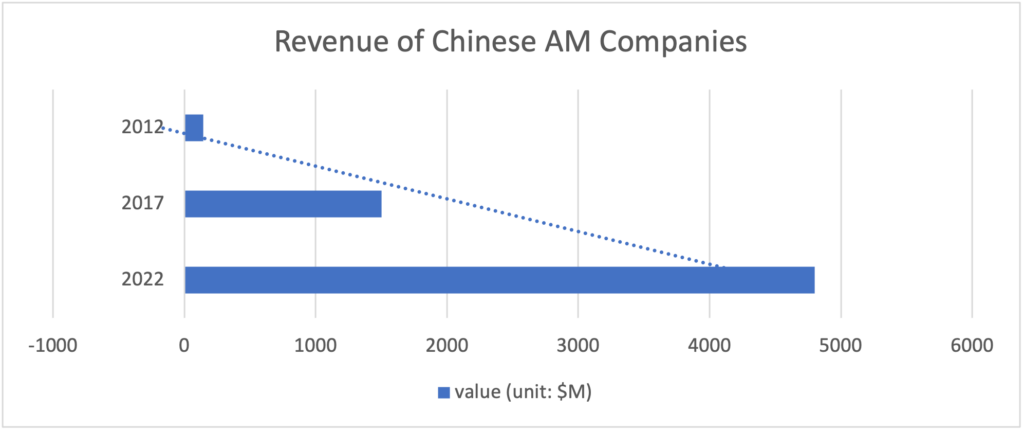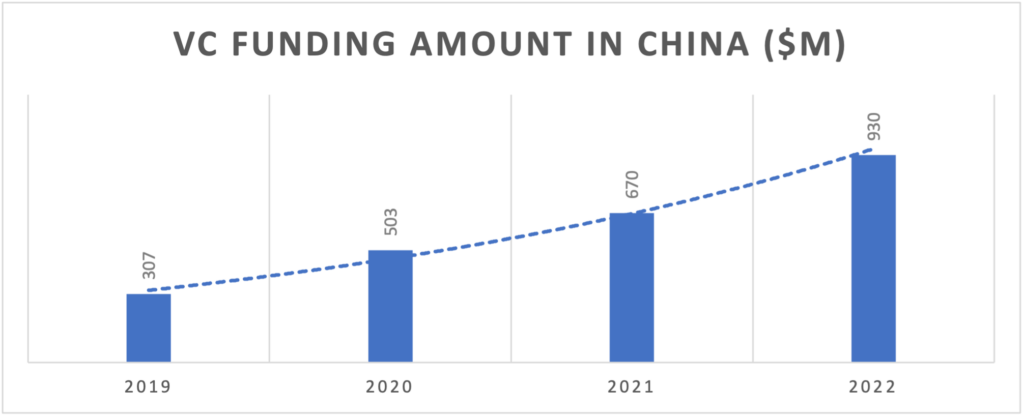The Chinese additive manufacturing (AM) market has emerged as a formidable force in the global 3D printing industry, witnessing exponential growth and remarkable success stories in the past decade. Today, while the global AM market is struggling to continue its exponential growth, there are several compelling reasons why we need to pay close attention to this dynamic and rapidly evolving segment.
Where is the Chinese AM Market Today?
A. Market Growth
The Chinese AM market has witnessed continued strong growth, fueled by advancements in metal 3D printing technology and its diverse applications. The industry has rapidly expanded in recent years, with a strong focus on metal AM, which has found extensive use in sectors such as aerospace, biomedical, industrial mold, and power energy. China’s AM journey in the past decade resulted in an output value increase to over $4.8 billion in 2022 with CAGR 32% since 2012, which is about 10% higher than the global average.
B. Diverse and Vibrant Ecosystem
With over 1,000 AM enterprises in the industry chain, China’s 3D printing ecosystem is vibrant and dynamic. Startups and established companies alike are exploring new use cases and expanding their capabilities, transforming the industry from rapid prototyping to encompass a wide range of applications.
C. Robust Venture Capital Investment
Despite global financial tightening, the Chinese AM sector has continued to be an active investment track with significant potential for sustained growth. Venture capital investment in Chinese AM startups has witnessed a remarkable growth in recent years, with 2022 alone witnessing a staggering $930 million influx from capital markets. This upward trend in VC investment signifies the industry’s attractiveness to investors and its potential for further expansion.
D. Market Leader Success Stories
Several Chinese AM companies have achieved remarkable success and have been listed on the stock market, garnering significant attention from investors. Notably, Xi’an Bright Laser Technologies Co., Ltd. (BLT) stands out as a market leader, especially in the metal 3D printing segment. BLT’s listing on the Shanghai Stock Exchange (688333.SS) has been met with enthusiasm, and its market capitalization has surpassed that of well-established international players like 3D Systems and Stratasys.
BLT’s success can be attributed to the increasing adoption of metal AM in critical industries. According to iResearch, more than 70% of BLT’s equipment is used in aerospace manufacturing.
Other active players in the Chinese AM market include Farsoon Technologies, Shining 3D, and UnionTech. Farsoon Technologies has been at the forefront of industrial 3D printing, collaborating with major aerospace and automotive manufacturers and eventually went public on the Shanghai Exchange on April this year. Shining 3D’s contributions in the biomedical sector have resulted in patient-specific medical implants and dental aligners. UnionTech’s expertise in large-scale SLA 3D printing has revolutionized the production of prototypes and tooling for various industries.
Major Challenges to Overcome
Despite its impressive growth and success, the Chinese AM companies faces certain challenges that need to be addressed for sustained development:
A. Fierce Price Competition
Price competition among AM companies can impact profit margins. To stand out in the competitive landscape, companies need to differentiate themselves by focusing on quality, unique offerings, and value-added services.
B. Maturity of Large-Scale Metal 3D Printing
Chinese metal AM machines are already competitive in the domestic market for small build sizes but for medium and large build sizes (250-1000 mm), overseas brands still have an advantage in the Chinese market. Developing large-scale metal 3D printing technology with enhanced efficiency and reliability is essential to cater to the demands of industries requiring complex and large metal parts.
C. Talent Shortage
The AM industry faces a shortage of skilled talent in additive manufacturing technologies, design, and post-processing. Addressing this issue through education and training initiatives will be vital in fostering innovation and sustained growth.
D. Cooperation and Internationalization
While China’s AM market has experienced rapid growth domestically, fostering international cooperation and expanding its global presence will be crucial for sustained growth. Collaboration with international partners can bring in diverse perspectives, access to new markets, and foster technology exchange, ultimately strengthening China’s position in the global AM industry.
Startups: Key for Innovation
Startups play a critical role in driving innovation within the Chinese AM market. As venture capital investment continues to flow into the sector, startups are well-positioned to explore new applications, develop cutting-edge technologies, and collaborate with industries to address their specific needs.
These startups not only introduce novel solutions but also fuel healthy competition, which drives the industry’s growth and pushes for advancements. Moreover, startups act as a bridge between research institutions and industrial applications, leading to a broader and more sustainable ecosystem for additive manufacturing in China.
Bottom Line
In conclusion, the Chinese Additive Manufacturing (AM) market has demonstrated remarkable and sustained growth, fueled by advancements in metal 3D printing technology and its wide range of applications. As the market continues to expand, it is exerting a significant influence on the global AM industry landscape. Through active international cooperation and strategic global expansion, China is well-positioned to strengthen its role as a key player in the additive manufacturing domain. The success of companies like BLT and Farsoon, who are top ranked on the global stock market, further solidifies the reputation of the Chinese AM industry on the global stage.
In future articles, we will delve deeper into an exploration of various AM companies in China, aiming to uncover their core strengths and their pivotal roles in shaping the global AM market.
Feature image: A total of 11 Farsoon’s 403P and Flight 403P systems installed at service bureau WeNext. Image courtesy of WeNext.
Subscribe to Our Email Newsletter
Stay up-to-date on all the latest news from the 3D printing industry and receive information and offers from third party vendors.
Print Services
Upload your 3D Models and get them printed quickly and efficiently.
You May Also Like
Nikon SLM Solutions Sells SLM 500 to Primary Weapon Systems to Expand Suppressor Production
Primary Weapons Systems (PWS) is a Boise, Idaho-based manufacturer of suppressors, firearms, and related components. A subsidiary of Vigilant Gear and a sister company to aftermarket Glock slide manufacturer Lone...
3DPOD 261: Tooling and Cooling for AM with Jason Murphy, NXC MFG
Jason Murphy´s NXC MFG (Next Chapter Manufacturing) is not a generalist service; instead, the company specializes in making tooling. Using LPBF and binder jet, the company produces some of the...
HP and Firestorm Labs Form Partnership to Use Multi Jet Fusion 3D Printers in Deployable Factories
HP Inc., maker of a range of additive manufacturing (AM) solutions including the Multi Jet Fusion (MJF) ecosystem, has announced a partnership with Firestorm Labs, a developer of containerized, deployable...
3D Printing News Briefs, July 2, 2025: Copper Alloys, Defense Manufacturing, & More
We’re starting off with metals in today’s 3D Printing News Briefs, as Farsoon has unveiled a large-scale AM solution for copper alloys, and Meltio used its wire-laser metal solution to...



































